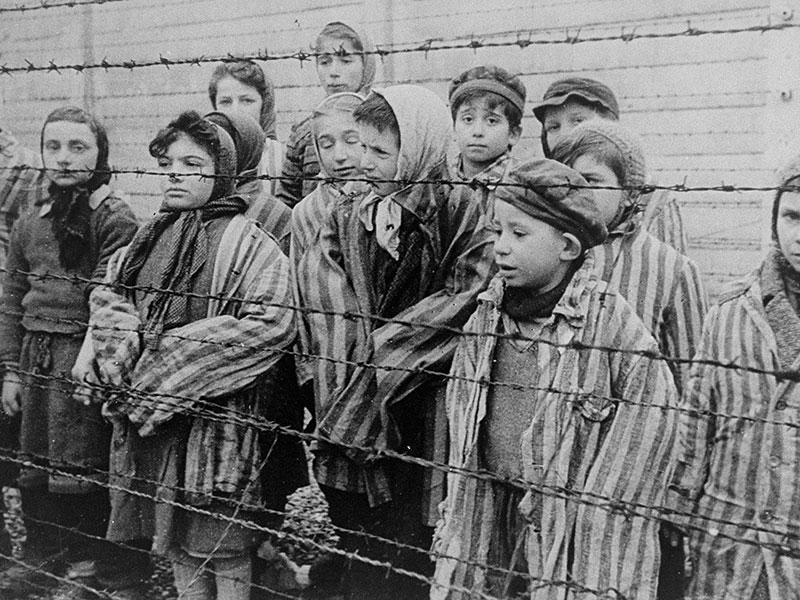Table of Contents
Books for Younger Readers
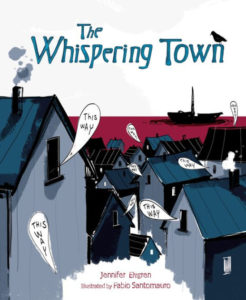 |
In Jennifer Elvgren’s picture book The Whispering Town (Kar-Ben Publishing, 2014), set in 1943 in German-occupied Denmark, Anett’s family is hiding a Jewish mother and son until they can be taken on board a fishing boat to Sweden. The entire town joins in a plan of Anett’s to get the pair safely to the harbor. For ages 5-8. |
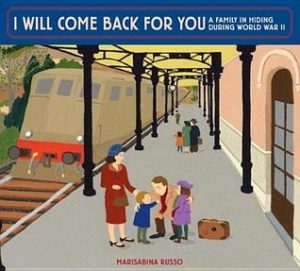 |
In Marisabina Russo’s I Will Come Back for You (Schwartz & Wade, 2011), a Jewish grandmother tells her young granddaughter the story of her childhood in Italy, when she and her family hid from the Germans on a little farm in the mountains. Nonna, the little girl’s grandmother, uses charms on her charm bracelet as memory cues. Based on a true family story. For ages 5-9. |
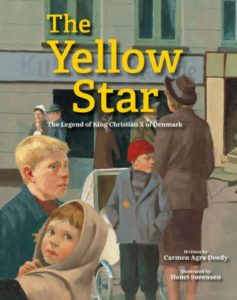 |
Carmen Agra Deedy’s The Yellow Star (Peachtree Publishing, 2020) is the story of Danish King Christian X who – when the Nazis took over Denmark and attempted to force all Jews to wear a yellow star – donned a yellow star himself and urged all his countrymen to do the same. There’s reason to believe that this story is more legend than history – but there’s a kernel of truth here and it’s an inspiring tale for ages 6-9. |
|
See The King of Denmark Wore a Yellow Star for a fact-check version of the story. |
|
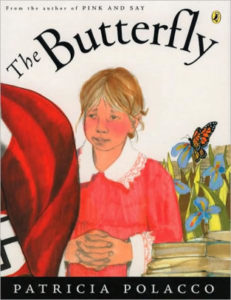 |
Patricia Polacco’s The Butterfly (Puffin, 2009), set in France during the Nazi occupation, is the story of young Monique who wakes up one night to discover a strange little girl at the foot of her bed. Her name is Sevrine and she is Jewish; Monique’s mother is hiding her family from the Nazis in a hidden basement room. When a neighbor sees Monique and Sevrine together, Sevrine’s family is forced to flee. The butterfly serves as a metaphor for Nazi brutality: a German soldier, seeing Monique admiring one, snatches it up and crushes it in his fist. For ages 6-9. |
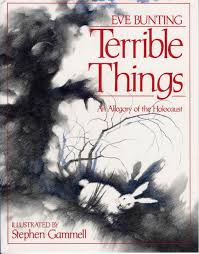 |
Eve Bunting’s picture book Terrible Things (Jewish Publication Society, 1989) is a Holocaust allegory. The Terrible Things have arrived in a woodland clearing and are capturing all the animals with feathers. Little Rabbit protests – “What’s wrong with feathers?” – but is silenced by the others. For ages 6-9. See here to read the story online, with a list of helpful discussion questions. |
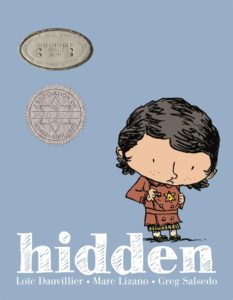 |
By Loic Dauvillier, in the graphic novel Hidden (First Second, 2014) Dounia, now a grandmother, tells her granddaughter about her experiences as a young girl in Nazi-occupied Paris in which she was hidden by neighbors and friends after her parents were sent to a concentration camp. For ages 6-10. |
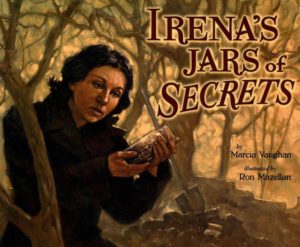 |
By Marcia Vaughan, Irena’s Jar of Secrets (Lee & Low, 2015) is the picture-book story of Irena Sendler who, during the German occupation of Poland, smuggled children out of the Warsaw Ghetto, finding them safe homes in orphanages and convents or with sympathetic families. She kept secret lists of the children’s identities in buried jars, intended to help them find their families again after the war. For ages 6-11. Also see Jennifer Rozines Roy’s Jars of Hope (Capstone, 2016), subtitled “How One Woman Helped Save 2500 Children During the Holocaust.” For ages 8-12. |
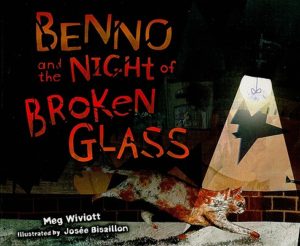 |
Meg Wiviott’s Benno and the Night of Broken Glass (Kar-Ben Publishing, 2010) is the story of Kristallnacht as seen through the eyes of Benno, an orange cat. The book begins with a description of ordinary life in his neighborhood – and then an account of the awful night when the Brownshirts smashed windows and set fires to Jewish homes, after which nothing was the same again. For ages 7-10. |
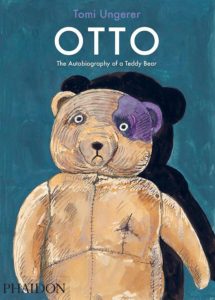 |
The star of Tomi Ungerer’s Otto: The Autobiography of a Teddy Bear (Phaidon Press, 2010) is Otto, played with by David, a Jewish boy, and his best friend Oskar in World War II Germany. David leaves the bear with Oskar when he and his family are sent to a concentration camp. Otto has an exciting wartime life, even managing to save the life of an American GI, who brings him home to his daughter in America – and eventually, long after the war is over, Otto brings David and Oskar together again. For ages 7-10. For more information on Otto from Brainpickings, see Otto: The Autobiography of a Teddy Bear. |
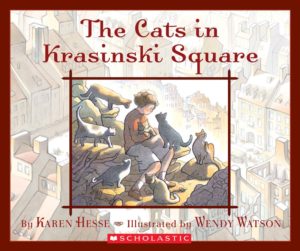 |
In Karen Hesse’s The Cats in Krasinski Square (Scholastic, 2010) – based on a true story – the cats play a crucial part in a plot to smuggle food and supplies to the Jews imprisoned in Poland’s Warsaw Ghetto. For ages 7-10. |
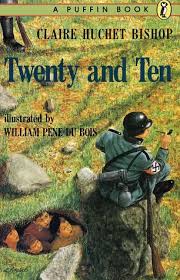 |
Claire Huchet Bishop’s Twenty and Ten (Puffin, 1978), set in occupied France, is the story of twenty French schoolchildren who, under the leadership of the courageous Sister Gabriel, save ten Jewish children from the Nazis. A short chapter book for ages 7-12.
|
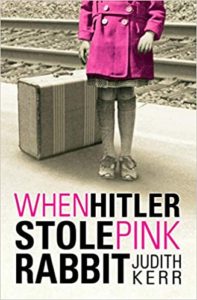 |
Based on the real-life experiences of the author, in Judith Kerr’s When Hitler Stole Pink Rabbit (Puffin, 2009), Anna and her family must flee Berlin, which is no longer safe for Jews. Nine-year-old Anna, her mother, and brother flee first to Switzerland, then to France, and finally to England, where they rejoin Anna’s father. They can take very little with them – and Pink Rabbit comes to represent all they ultimately left behind. For ages 8-12. |
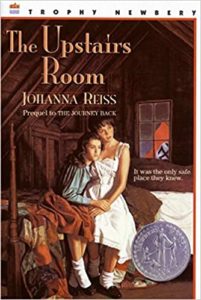 |
Set during the German occupation of Holland, in Johanna Reiss’s award-winning The Upstairs Room (HarperCollins, 2019), ten-year-old Anna and her sister, in danger because they are Jewish, spend two years hidden in a tiny cramped room in a remote farmhouse. For ages 8-12.
|
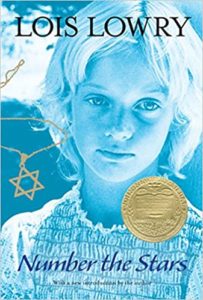 |
In Lois Lowry’s Number the Stars (Houghton Mifflin Harcourt, 2011), the Germans have invaded Denmark and have begun a campaign to relocate Danish Jews. Annemarie Johansen’s family is concealing Annemarie’s Jewish best friend, Ellen Rosen – and in the meantime the Danish resistance is working to evacuate the entire Jewish population of Denmark across the sea to safety in Sweden. Highly recommended for ages 9 and up. |
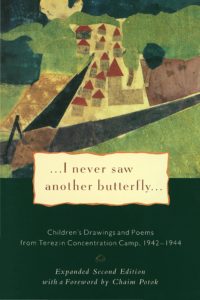 |
I Never Saw Another Butterfly (Schockers, 1994) is a collection of children’s drawings and poems from the Terezin concentration camp between 1942 and 1944. Fifteen thousand children under the age of fifteen passed through the camp; fewer than 100 survived. A beautiful and heartbreaking book for ages 9 and up. |
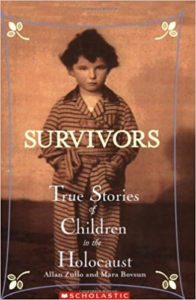 |
Allan Zullo’s Survivors (Scholastic, 2005) is a collection of true stories of nine Jewish children who survived the Holocaust, among them that of ten-year-old Mathei, who escaped from a cattle car en route to Auschwitz and became a resistance fighter, and of five-year-old Sarah, who spent two years hiding in the attic of a Polish family. For ages 9-12.
|
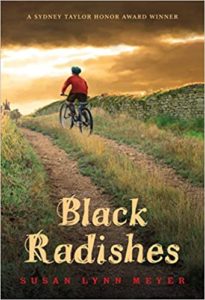 |
In Susan Lynn Meyer’s suspenseful Black Radishes (Yearling, 2011), young Gustave and his Jewish family have fled Paris when the Nazis occupy France. They settle in Saint-Georges, a village in the French free zone, where they become involved with the French resistance. Where the black radishes come in? In a plot to smuggle Jews out of the occupied zone, Gustave uses them to distract the border guards, because the German soldiers like them, salted, with their beer. For ages 9-12. |
